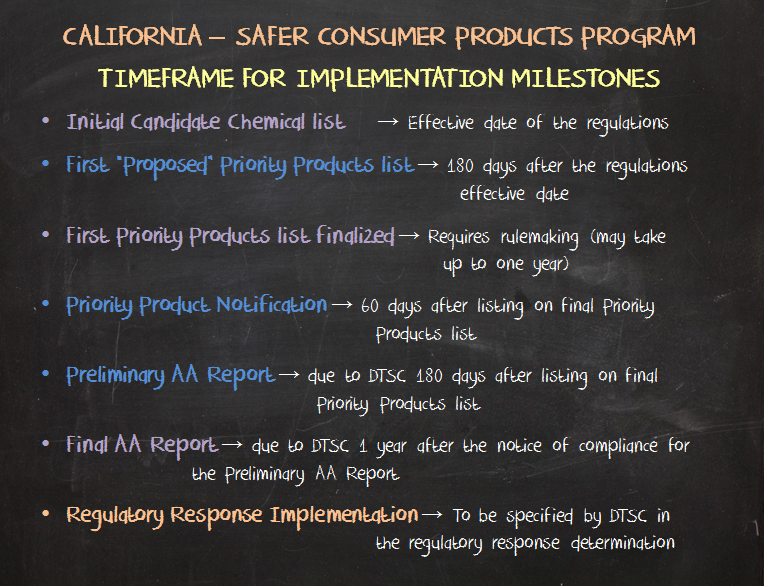 What is the Safer Consumer Products (SCP) Program?
What is the Safer Consumer Products (SCP) Program?
The California Department of Toxic Substances Control's (DTSC) Safer Consumer Products regulations take effect October 1, 2013 and will be phased in over the next several years to coordinate with the timing of the various regulatory requirements.
The goals of this program are to reduce toxic chemicals in consumer products, create new business opportunities in the emerging safer consumer products economy, and reduce the burden on consumers and businesses struggling to identify what’s in the products they buy for their families and customers.
To accomplish these goals, the SCP Program will rely on reports submitted by responsible entities, such as the manufacturer, to inform and increase the use of safer chemicals in products, homes, schools, and workplaces, which produce significant environmental and economic benefits.
By shifting the question of an ingredient’s toxicity to the product development stage, concerns can be addressed early on. The approach results in safer ingredients and designs, and provides an opportunity for California industry to once again demonstrate its innovative spirit by making products that meet consumer demand throughout the world.
The California legislature passed the
Green Chemistry Law in 2008 which authorizes and requires DTSC to adopt regulations to establish a process to identify and prioritize chemicals in consumer products and to establish a process for evaluating chemicals of concern in consumer products and their potential alternatives.
Summary of the Proposed Safer Consumer Products Regulations
The regulations provide for a four-step continuous, science-based, iterative process to identify safer consumer product alternatives:
| |
-
Chemicals – The regulations establish an immediate list of Candidate Chemicals (~1,200) based on the work already done by other authoritative organizations, and specify a process for DTSC to identify additional chemicals as Candidate Chemicals (CCs).
-
Products – The regulations require DTSC to evaluate and prioritize product/Candidate Chemical combinations to develop a list of “Priority Products” for which Alternatives Analyses must be conducted. A Candidate Chemical that is the basis for a product being listed as a Priority Product is designated as a Chemical of Concern (COC) for that product.
-
Alternatives Analysis – The regulations require responsible entities (manufacturers, importers, assemblers, and retailers) to notify DTSC when their product is listed as a Priority Product. DTSC will post this information on its web site. Manufacturers (or other responsible entities) of a product listed as a Priority Product must perform an Alternatives Analysis (AA) for the product and the COCs in the product to determine how best to limit exposures to, or the level of adverse public health and environmental impacts posed by, the COCs in the product.
-
Regulatory Responses – The regulations require DTSC to identify and require implementation of regulatory responses designed to protect public health and/or the environment, and maximize the use of acceptable and feasible. DTSC may require regulatory responses for a Priority Product (if the manufacturer decides to retain the Priority Product), or for an alternative product selected to replace the Priority Product
|
What are the goals of the SCP Regulations and Program?
DTSC’s Safer Consumer Products Regulations aim to create safer substitutes for hazardous ingredients in consumer products sold in California. The regulations emphasize safer products and healthier lives by reducing and eliminating use of toxic chemicals.
How are the SCP Regulations related to the Green Chemistry Law?
In 2008, Assembly Bill 1879 (Chapter 559, Feuer) and Senate Bill 509 (Chapter 560, Simitian), were signed into law by Governor Schwarzenegger to implement two key recommendations of the California Green Chemistry Initiative Final Report: acceleration of the quest for safer products, and creation of an online toxics clearinghouse. These two legislative bills comprise the Green Chemistry Law. Assembly Bill 1879 mandated the Safer Consumer Products Regulations and authorized the implementation of the Safer Consumer Products Program. Senate Bill 509 mandated the Office of Environmental Health Hazard Assessment to specify hazard traits, environmental and toxicological endpoints and other relevant data to be included in the Toxics Information Clearinghouse.
The regulations and the authorizing statutes (Health and Safety Code sections 25252 and 25253), are intended to implement recommendation #5 of the California Green Chemistry Initiative Final Report—Accelerate the Quest for Safer Products, and, thus, create a systematic, science-based process to evaluate chemicals of concern, and identify safer alternatives to ensure product safety.
Related Links:
- California Department of Toxic Substances Control's (DTSC)
- Safer Consumer Product Regulations
- Safer Consumer Product web portal
- Green Chemistry Law (2008)
- Informational "Initial" List of Candidate Chemicals and Chemicals Groups (13 October 2013)
- DTSC’S Initial Proposed Priority Products List for the Safer Consumer Products
Program (13 March 2014)
